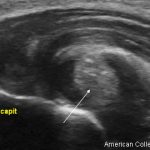It is my sincere hope that ultrasound continues to evolve in a way that strengthens our fellows’ understanding of anatomy and enhances their physical exam skills, so they can become better clinicians than we are.
TR: Why is ultrasound important in rheumatology?
JA: I could go on and on about that. But in rheumatology, we often lack confirmatory data. For example, take seronegative rheumatoid arthritis. When you look with ultrasound and see more enthesophytes or tendon involvement, you realize that perhaps this is spondyloarthritis. Or perhaps you’re dealing with crystalline disease instead. Ultrasound allows us to narrow down the differential and gives us more certainty with the treatment pathway we are choosing.
What’s more, ultrasound made me a much better musculoskeletal doctor. As rheumatologists, we are good at inflammatory conditions but musculoskeletal complaints often aren’t our strengths. Now that I’m trained with ultrasound, I have a better appreciation for anatomy, musculoskeletal structures and how they inform disease processes. It’s not just shoulder pain. Now I think in layers: Is it tendon, joint or bone? You can get much more nuanced and detailed in your thinking. Shoulder pain could indicate glenohumeral synovitis, bursitis, biceps tendinitis, etc., and this distinction is important when for caring for patients.
Dr. Kohler (MK): As technology has improved, point-of-care ultrasound (i.e., clinician-performed ultrasound at the patient’s office visit or bedside) has become more accessible within medical training among all medical specialties, including rheumatology. There has been growing evidence of the value of musculoskeletal ultrasound in rheumatology to differentiate inflammatory from mechanical conditions and identify subclinical inflammation and crystalline pathology to expedite diagnoses, monitor disease activity and provide needle guidance for diagnostic and therapeutic joint aspirations and injections. Ultrasound findings of various rheumatic conditions are also leading to better understanding of what joints, tendons or soft tissue structures may be involved, as well as detecting early erosive disease—ultrasound is more sensitive than X-ray.
TR: When should rheumatologists consider using ultrasound?
JA: There is really no scenario when you shouldn’t use it. That’s like asking, “Can I check labs?” But being judicious about its use is important, and I use it for scenarios in which I don’t have enough diagnostic certainty. For example, ultrasound is great when a patient isn’t responding to treatment and you need to rethink the diagnosis, or when clinical exam is discordant from labs or history.



